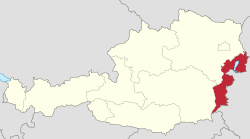Republic of Heinzenland Republik Heinzenland Republik Hoanznlaund (local dialect) Hiénc Köztársaság | |||||||||||
|---|---|---|---|---|---|---|---|---|---|---|---|
| 1918–1918 | |||||||||||
 | |||||||||||
| Status | Unrecognized state | ||||||||||
| Capital | Mattersburg | ||||||||||
| Government | Republic | ||||||||||
| Historical era | World War I | ||||||||||
• Established | December 5, 1918 | ||||||||||
• Disestablished | December 7, 1918 | ||||||||||
| |||||||||||
The Republic of Heinzenland (German: Republik Heinzenland; German pronunciation: [ʁepuˈbliːk 'haɪntsn̩lant]) was a short-lived and unrecognized nation in the region that is now known as the Austrian federal state of Burgenland. It was aimed at protecting the German-speaking population in Western Hungary. The state was a direct result of the disputes in Central Europe following the First World War on whether the future of Burgenland would be under Austrian or Hungarian control. Its main leader was the Social Democratic politician Hans Suchard. Its short life has made it known as the "Two-Day Republic". It was one of many unrecognized successor states in the region, including Lajtabánság and the Republic of Prekmurje.